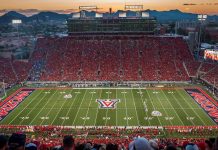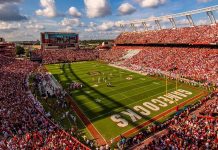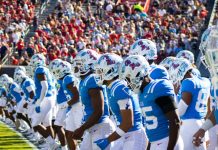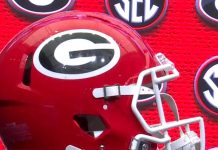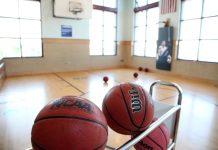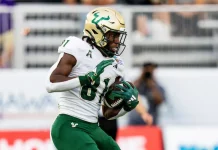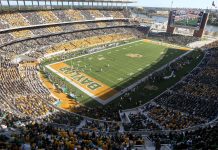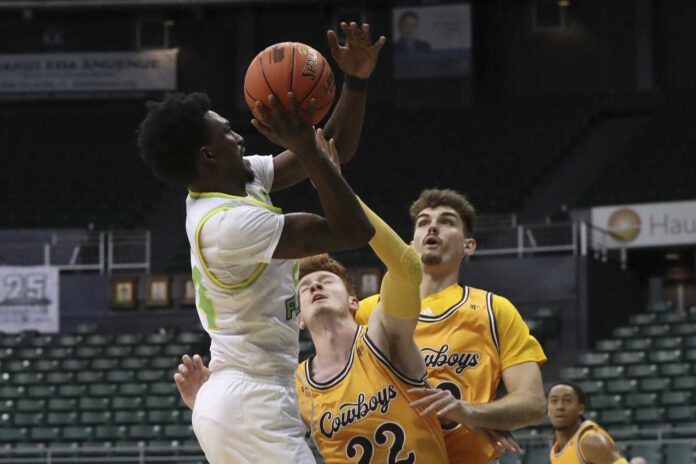
Nearly a year has passed since Lamont Butler hit a buzzer-beater that sent San Diego State to the NCAA championship game. He’s seen it so often on social media and TV that he never had search it out himself.
“It’s kind of hard to miss it,” he said.
Especially in March Madness.
Last-second shots fuel the NCAA Tournament’s allure. They are split-second moments that live for decades in highlights and memories. Butler is among those who did it last year and could get another chance as the tournament begins this week.
“I never thought about how big it was and the willingness to take it,” Butler told The Associated Press. “I was just like, ‘All right, we’ve got to win this game.’
“It’s just confidence. You’ve got to go out there and play fearless. Things are going to happen, mistakes are going to happen. The only way you can do something is if you go out there and try it.”
Florida Atlantic’s Nick Boyd and TCU’s JaKobe Coles felt that with first-round winners. So did Butler’s teammate, Darrion Trammell, whose free throw with 1.2 seconds left edged Creighton for a Final Four berth.
They’re all back. The Aztecs are the East Region’s No. 5 seed, Boyd’s Owls are the East’s No. 8 and Coles’ Horned Frogs are the Midwest’s No. 9.
Hitting one of those shots tests confidence and nerve. And they’re hard to come by considering all the variables that must line up perfectly – health, matchup, foul trouble – to even be on the court to make one.
But when they do, there’s magic like Villanova’s Kris Jenkins hitting a 3-pointer at the horn for the 2016 title or Luke Maye’s jumper with 0.3 seconds left that sent North Carolina to the Final Four and eventually the championship a year later.
Butler owns his own corner of history with that off-dribble 17-footer over the left arm of an FAU defender — coincidentally, Boyd — from the right side. He’s the first to hit a Final Four winner with his team trailing and no time left.
They are all life-altering events and being part of a select club starts with recognition.
“I didn’t understand how many people really watched and how many people that I knew really watched,” said Boyd, who scored with 2.5 seconds left to beat Memphis. I was able to get back in touch with third-grade teachers, principals from my middle school, people I haven’t talked to in 10 years.”
College Basketball Reference accounted for 130 winning baskets or free throws in the final 2 seconds back to the 1944 tournament. Some times are estimates, coming before the clock stopped after made baskets or included tenths-of-second breakdowns.
Two players appear twice: Duke’s Christian Laettner and Butler’s Matt Howard. Laettner stands alone for hitting both with his team down and no time remaining: a double-pump jumper against Connecticut in the 1990 Elite Eight, then the famed catch-and-turnaround against Kentucky in the 1992 Elite Eight en route to a second straight championship.
Countless others have come oh-so-close to joining the list. Max Abmas is one; he missed a buzzer 3-pointer to beat Arkansas in the 2021 Indianapolis bubble, ending 15th-seeded Oral Roberts’ unexpected Sweet 16 run.
“It was a tough one,” said Abmas, now with seventh-seeded Texas in the Midwest. “That’s one, of course, that I wanted back.”
Few understand the challenge better than Keith Smart.
Indiana trailed by one against Syracuse in the 1987 final when the 6-foot-1 junior took a feed on the left side, dribbled once to his left and swished a jumper with 4 seconds left in the Superdome. The shot secured Bob Knight’s third title and made Smart the Final Four’s most outstanding player.
A three-time NBA head coach and current Arkansas assistant, Smart points to collend pro players shooting all kinds of shots after practices or shootarounds: falling out of bounds, leaners, halfcourt shots, among them.
It’s more than just messing around.
“Most of the time, the guys who take those shots have all kind of got a good feel about themselves,” Smart said. “Mentally they’re strong, and they can probably deal with the consequences.
“I’ve seen over my coaching career, guys who won’t take that shot, don’t take it,” he added. “I can even see it sometimes when guys are practicing after the shootaround in different places, who’s actually up there shooting. And nine times out of 10, in that situation, here comes the guy taking that shot that’s practiced shooting from all angles of the floor. You never know when that moment is going to come.”
As for focus, Smart was consumed with mechanics after front-rimming a jumper moments earlier against Syracuse.
“I’ve got to ‘jump up, shoot up,’” Smart said, citing assistant coach Ron Felling. “I knew if I get that moment again, I would do that and that would put lift on my shot.”
Forward to 2023, and Coles mirrored Smart’s mindset before his tiebreaker against Arizona State.
Feeling his shot had been “kind of flat,” he took a pass and dribbled into the paint to shoot a left-foot floater with Desmond Cambridge Jr. contesting and 7-footer Warren Washington lurking nearby.
“I just remember when I drove that, ‘I just need to get this ball a little higher than I have been throughout the game,’” Coles said.
The ball swished through with 1.5 seconds left for the 72-70 win.
The same night, on the other side of the bracket, Boyd’s confidence spoke out of turn as FAU faced elimination with 5.5 seconds left.
“As we’re walking to the timeout, my emotions are flowing and for some reason I’m saying, ‘Coach, let me get it,’” Boyd recalled, adding: “Sometimes I just say things out of emotion, not really meaning it 100%.”
Dusty May promptly called an inbounds play for him.
“I’m like, ‘Oh snap, what did I just get myself into?’” Boyd said.
Boyd squared up on the corner catch to take a 3-pointer, but Memphis’ Elijah McCadden closed out quickly. So he went off the bounce past Vladislav Goldin’s postup-turned-screen.
The 6-3 Boyd elevated at the rim against 6-7 defender Chandler Lawson before falling to the court. The ball rattled around before dropping in for the 66-65 lead. Boyd scrambled to his feet for the Tigers’ final futile possession in the win that ignited the Owls’ unlikely Final Four run.
“There’s no reason for me not to be ready,” Boyd said. “I asked for it.”
For Butler, he knew the plan from an earlier timeout was for him to look for a shot. Down one, the Aztecs’ Nathan Mensah grabbed a rebound and passed out to Butler. The 6-2 guard crossed midcourt with 6 seconds left aiming to drive the baseline, only for Boyd to cut him off.
Time and options dwindling, Butler dribbled between his legs to get to his left hand, dribbled once more, then shot.
“I kind of knew it was good because it looked so high in the air,” Boyd said.
The horn sounded. The ball swished. Aztecs reserves sprinted onto the court to mob Butler. Amid that chaos, Butler’s biggest memory is seeing family members celebrating in seats near where he took the shot.
“I feel like that was one of the best moments, to be able to see them and they were all lit up,” Butler said. “And to be bombarded by my teammates like that. Everybody was so happy, everybody’s face was so shocked. It’s definitely a moment I’ll never forget.”
That illustrates why Smart views those moments as about more than just one shotmaker.
“We’re all connected by the ring. By the moment. By the shot,” Smart said. “I may get credit, talk in the paper about it. But you remember the teammates that were on your team. That’s what goes with you the rest of your days. … All those guys remember, ‘Man, I remember that shot you made.’ It’s just a great moment for them.”
The memories mean more to Boyd, too. He tries to “relive the moment” when he watches a replay, but not too often so it doesn’t somehow diminish the emotions.
There might not be a choice. Those shots belong to tournament lore now.
“If it’s on 20 years later and I see it, I’m going to have the same smile on my face,” Coles said. “And hopefully one day my kids and grandkids will be able to see that video one day and be appreciative of it.”
___
AP Sports Writer Stephen Hawkins in Fort Worth, Texas; and freelance writer Mark Rosner in Austin, Texas; contributed to this report.


